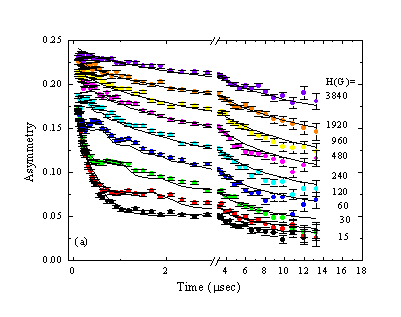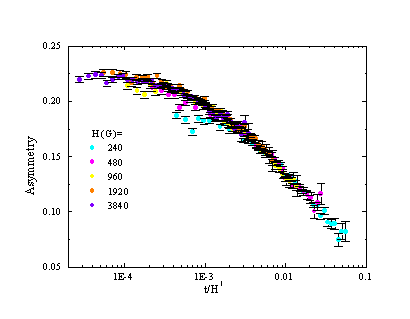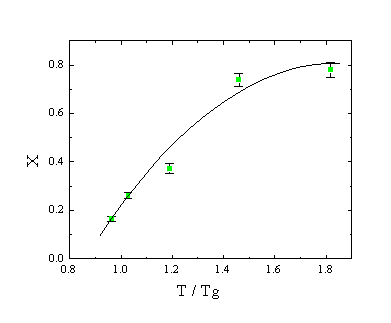Our major finding is:
Mapping exotic spin correlations by field dependent muon spin-lattice relaxation measurements.
Traditionally, the spin lattice relaxation time of a muon in a magnetic environment, also known as T1, is interpreted using the concept of spin correlation time. However, in some situations, no correlation time could be assigned to the spins, and a different interpretation of T1 is required. Our group recently developed such an interpretation. As a test case spin glasses where chosen since the theoretical expectation is for a time scale invariant spin evolution over a few decades. Indeed, the experiments show that the spin correlation function is best described by a product of a power law and a cut-off functions and that the slowing down spin fluctuations are manifested essentially by the temperature dependence of the power law term.
In a muon field dependent T1 measurements, one determines the time t it takes the polarization P(H,t) of a muon to reach thermal equilibrium with the system under investigation, from an initial non-equilibrium polarization. The magnetic field H is applied along the initial muon spin direction. The muon flip rate (1/T1) depends on how popular is the Larmor frequency (wL=gmH) among the lattice fluctuations, since in order for the muon to flip from up to down states it must absorb, or release, the energy hwL to the lattice (depending on the field direction). In other words, T1 will be short if the Fourier transform of the spin-spin correlation function q(t)=<S(t)S(0)> atwL is large, and vice versa.
Figure 1 Asymmetry versus time in the spin glass AgMn(0.5 @ %) at T>Tg for various longitudinal magnetic fields. The solid lines are fit to a model relating T1 to a correlation function, and a cutoff power law function (as in Eq. 1) is used.
It is customary to assume that the correlation function decays exponentially with some correlation time t and therefore the Fourier transform of q(t) is a Lorentzian in terms of the field H. Thus, at asymptotically high fields we expect T1 proportional to H2, and the muon polarization P(H,t) should be a function of the ratio t/H2. This conclusion holds even if instead of having a single correlation time in the system there is a distribution of t’s. However, the assumption that there is a correlation time could be incorrect to start with, and in many complex systems q(t) can be strongly non-exponential, with time scale invariance or hierarchical relaxation. Here we demonstrate the presence of non-exponential correlation functions in nature by performing mSR measurements on the Heisenberg spin glass AgMn(0.5 at. %). We chose this system since numerical work on glasses indicates the presence of “exotic” correlation functions. We also show how to determine the functional form of q(t) using the field dependent muon depolarization measurements.
Figure 2 The asymmetry from Fig. 1 plotted as a function of t/H for fields higher than 240 G. The fact that the asymmetry is a function oft/H and not t/H2 rules out the possibility of describing the spin correlation function with one or many correlation times.
Figure 1 shows representative data sets of the muon asymmetry A(H,t), which is proportional to P(H,t), at T=2.9 K (above Tg=2.8K) and at various fields. Note the break in the time axis. Clearly, H affects the muon polarization very strongly over more than two orders of magnitude in magnetic field. In order to test whether a single or a distribution of correlation time could describe this system we normalize the time t by the field to some power. We found that for high fields, the muon polarization is a function of t/H and not t/H2. This is demonstrated in Fig. 2. Thus, an exponential relaxation function or even a sum of exponential relaxations cannot account for this data. One must search for a correlation function whose Fourier transform falls off like 1/w at high frequencies. This requirement determines the behavior of the correlation function at early times.
For low values of H, in Fig. 1 clear wiggles are observed in the beginning of the data. The source of the wiggles are those muons for which a local transverse magnetic field BT , has not relaxed abruptly during the time of one rotation. These muons will oscillate around the vector sum of both internal and external fields at a frequency w=gm(H2+BT2)1/2. Since at T>Tg there is a distribution of BT with zero average, the contribution of the local internal fields will show up as a relaxation of the wiggles, while the frequency of the wiggles will be at wL. However, if there is a cutoff time t, then by the time t>t abrupt field relaxation occurs for all muons. Therefore, wiggle pattern will not be seen for longer times. As a result, the observation of a “wiggle” pattern up to time t is the proof that there are local fields that do not relax abruptly within time t. Thus the observation of wiggles gives us a model independent estimate of t.
The combination of the asymptotic field dependence shown in Fig. 2 and the wiggles observed in Fig. 1 forces us to consider a cut off power law correlation function of the form
where x is a dynamical power. This, in fact, is the function used to analyze most of the molecular dynamic numerical work on spin glasses. In our paper we demonstrate how this function is introduced into the general theory of spin-lattice relaxation. The fits shown in Fig. 1 are obtained using this theory and Eq. 1. The fits capture the long time behavior very well and the frequency of the wiggles. However, the account for the relaxation of the wiggles is not perfect.
We have performed these measurements at different temperatures above Tg. At each temperature data was collected at 9 different fields and the value of x was determined. In Fig. 3 we depict x(T). As the temperature decreases x decreases. In fact, our analysis show that x is the only temperature dependent parameter. Therefore, stretching out the power law part and making x small manifests the slowing down of spin fluctuation upon cooling.
Figure 3 The dynamic power x (from Eq. 1) plotted versus temperature. The slowing down of spin fluctuations is manifested in the decrease of x upon cooling.
The Israeli Academy of Science funded this research project. The project name is Muon spin relaxation in spin glasses, and its duration was 1997-2000. The principal investigator is Amit Keren.
We have published the following papers on the subject:
- A. Keren, F. Gulener, I. Campbell, G. Bazalitsky, and A. Amato, Dynamical crossover in an Ising spin glass above Tg; a mSR investigation of Fe0.05TiS2, Phys. Rev. Lett. 89, 107201 (2002).
Abstract:
We investigate the temperature dependence of the spin-spin dynamical auto correlation function of the Ising spin glass Fe0.05TiS2 through field dependent muon spin lattice relaxation measurements. We successfully analyze the results using the Ogielski function, namely, t-xexp(-[t/t]y) as employed in numerical simulations. The experimental estimates of x, y, and t are compared with those from simulations. Our major finding is that in this system the correlation function changes its nature from Ogielski to a form indistinguishable from pure stretched exponential upon cooling close to Tg, indicating a dynamical crossover.
- A. Keren, G. Bazalitsky, I. Campbell and J. Lord, Probing exotic spin correlations by muon spin depolarization measurments with application to spin glass dynamics, Phys. Rev. B 64, 054403 (2001).
Abstract:
We develop a new method to probe the local spin dynamic autocorrelation function, using agnetic field dependent muon depolarization measurements. We apply this method to mSR experiments in the dilute Heisenberg spin glass AgMn(p at. %) at T>Tg where the correlations of the Mn local magnetic moment are strongly non-exponential. Our results clearly indicate that the dynamics of this spin glass cannot be described by a distribution of correlation times. Therefore, we analyze the data assuming a local spin correlation function which is the product of a power law times a cutoff function. The concentration and temperature dependence of the parameters of this function are determined. Our major conclusion is that in the temperature region close to Tg the correlation function is dominated by an algebraic relaxation term.
- A. Keren and Galina Bazalitsky, Muon polarization in the presence of exotic spin correlations, Physica B 289-290, 205-208 (2000).
Abstract:
We investigate the signatures of the correlation functions q(t)=2ct-xexp[ -(nt)y] on the muon polarization P(H,t), in a longitudinal field [H] experiment. We find three major features: (I) P'(H,0)=0 as for a Gaussian, (II) the smaller the x the easier the decoupling, and (III) there is always time t long enough, and H high enough that scaling relations of the form P(H,t)=P(t/Hg) hold; if g < 1 then g=1-x; however if g > 1 then g =1+y. The required range for t and H where scaling should exist is discussed.
- A. Keren, G. Bazalitsky, P. Mendels, I. Campbell, and J. Lord, Magnetic field-time scaling relations and exotic spin correlations: a mSR study of spin-glasses, Physical B 289-290, 202-204 (2000).
Abstract:
In this work we analyze a longitudinal field HmSR experiment in the spin glass AgMn(0.5 at. %) using a cut-off power law dynamical field auto correlation function q(t)=2ct-xexp[ -(nt)y]. This function allows us to account for the data for more than 2.5 orders of magnitude in magnetic field and two orders in time. Our results suggest that spin glass freezing is associated with a dynamical transition from a cut-off power law to a pure cut-off.
- A. Keren, P. Mendels, and I. A. Campbell, Probing the spin-spin dynamical autocorrelation function in spin glass AgMn above TgusingmSR, Phys. Rev. Lett. 77, 1386-1389 (1996).
Abstract:
We report zero and longitudinal field muon spin relaxation measurements in the metallic spin glass AgMn(0.5 at %) at T>Tg. We find that the muon polarization obeys a time-field scaling relation which allows us to distinguish between three possible forms of the spin-spin dynamical autocorrelation function: a power law, a stretched exponential, and a cutoff power law. We also discuss the evolution of the muon relaxation line shape as the temperature approaches Tg.


